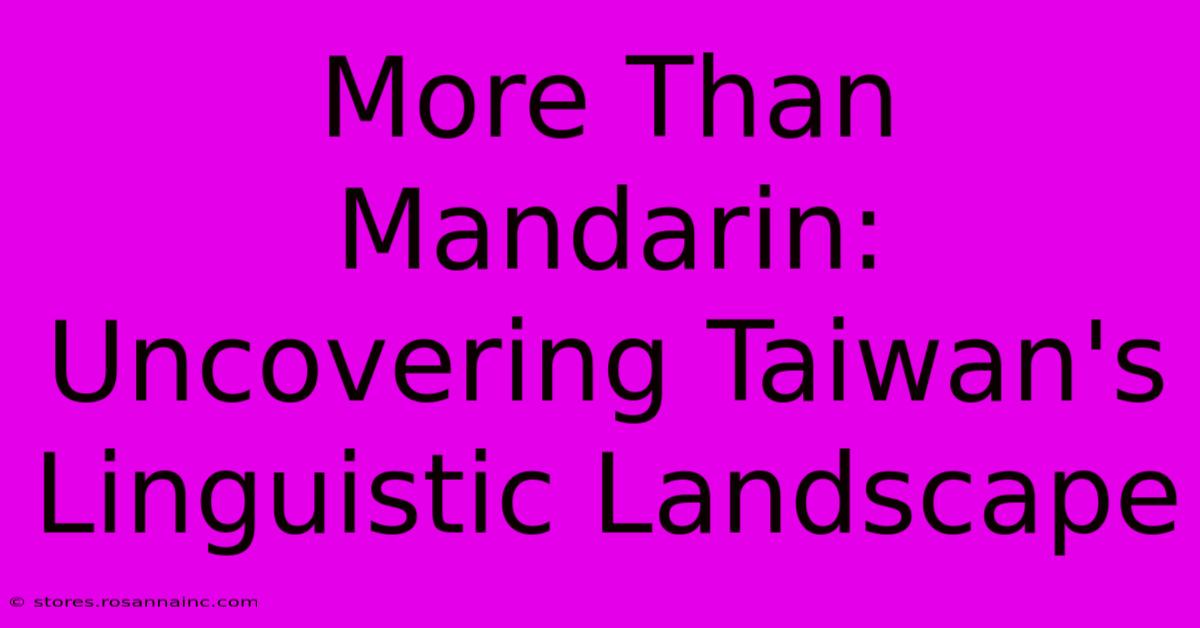More Than Mandarin: Uncovering Taiwan's Linguistic Landscape

Table of Contents
More Than Mandarin: Uncovering Taiwan's Linguistic Landscape
Taiwan, a vibrant island nation brimming with culture and history, is often associated solely with Mandarin Chinese. However, this perception overlooks the rich tapestry of languages that contribute to Taiwan's unique linguistic landscape. Delving beyond the dominant language reveals a fascinating story of indigenous tongues, immigrant dialects, and the evolving role of language in shaping Taiwanese identity. This exploration unveils a far more complex and compelling linguistic reality than a simple "Mandarin-only" narrative suggests.
The Indigenous Languages: A Heritage Under Reconstruction
Before the arrival of significant numbers of Han Chinese, Taiwan was home to a diverse array of indigenous Austronesian languages. These languages, belonging to the Malayo-Polynesian family, represent a significant part of Taiwan's cultural heritage. Unfortunately, decades of language suppression have led to a significant decline in the number of fluent speakers.
Facing Extinction: The Struggle for Survival
Many of these indigenous languages are critically endangered, facing the very real threat of extinction. Factors contributing to this decline include:
- Forced assimilation policies: Past government policies actively discouraged the use of indigenous languages in favor of Mandarin.
- Social pressure: Speaking indigenous languages often carried social stigma, leading to language shift towards Mandarin.
- Lack of intergenerational transmission: With fewer elders speaking their native tongues, the knowledge and transmission of these languages are at risk.
Revitalization Efforts: A Beacon of Hope
Despite the challenges, significant efforts are underway to revitalize and preserve these languages. These efforts include:
- Language immersion programs: Schools and communities are implementing programs to teach indigenous languages to younger generations.
- Language resource development: Dictionaries, textbooks, and other resources are being created to support language learning and revitalization.
- Community initiatives: Indigenous communities are actively promoting the use of their languages in everyday life.
Beyond Mandarin: The Influence of Immigrant Languages
Taiwan's history as a melting pot of cultures is reflected in the presence of various immigrant languages. The arrival of people from mainland China, Southeast Asia, and other parts of the world has enriched Taiwan's linguistic diversity.
Min Nan (Hokkien): A Widely Spoken Dialect
Min Nan, often referred to as Hokkien, is arguably the second most widely spoken language in Taiwan. Its presence is deeply rooted in the island's history, and it continues to play a vital role in Taiwanese culture and identity.
Hakka: A Resilient Language
Hakka, another significant Chinese dialect spoken in Taiwan, demonstrates remarkable resilience. Despite facing pressures from Mandarin and Min Nan, Hakka communities maintain their linguistic heritage through various initiatives.
Other Immigrant Languages: A Mosaic of Voices
Beyond Min Nan and Hakka, other immigrant languages contribute to Taiwan's linguistic richness. These languages represent the diverse backgrounds of Taiwan's population and add to its vibrant cultural mosaic.
The Role of Mandarin: Dominant but Not Exclusive
While Mandarin's dominance is undeniable, understanding Taiwan's linguistic landscape requires recognizing its role within a broader context. It's crucial to avoid viewing Mandarin as a monolithic entity that eclipses all other languages.
Mandarin as a Unifying Force?
Mandarin's adoption as the national language has contributed to national unity and facilitated communication across different linguistic groups. However, this unification shouldn't come at the cost of suppressing other languages.
The Future of Linguistic Diversity in Taiwan
The future of Taiwan's linguistic landscape depends on a conscious effort to preserve and promote linguistic diversity. This requires government support, community engagement, and a wider societal understanding of the importance of multilingualism.
Conclusion: Embracing Linguistic Plurality
Taiwan's linguistic landscape is far more intricate and fascinating than a superficial view suggests. By exploring the indigenous languages, immigrant dialects, and the evolving role of Mandarin, we gain a deeper understanding of the island's rich history and vibrant culture. Preserving this linguistic diversity is not merely a matter of preserving languages; it's about preserving the very fabric of Taiwanese identity and ensuring a rich cultural legacy for future generations. The future of Taiwan's linguistic landscape depends on a commitment to embrace and celebrate its linguistic plurality, recognizing that true national unity can coexist with the vibrant expression of diverse linguistic heritage.

Thank you for visiting our website wich cover about More Than Mandarin: Uncovering Taiwan's Linguistic Landscape. We hope the information provided has been useful to you. Feel free to contact us if you have any questions or need further assistance. See you next time and dont miss to bookmark.
Featured Posts
-
Reaves Explodes For 45 Lakers Win
Feb 09, 2025
-
The Forbidden Citys Fallen Angel
Feb 09, 2025
-
Finally The True Meaning Of Smekday Explained
Feb 09, 2025
-
The Magic School Bus Books Adventure And Learning Await
Feb 09, 2025
-
Cleveland 79 Finding Hope After Tragedy
Feb 09, 2025
